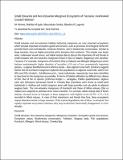| dc.description.abstract | Small estuaries and non-estuarine habitats harboring mangroves are very important ecosystems which provide important ecosystem goods and services; such as provision of ecological niches for juvenile fishes and invertebrates, enhances fisheries, and in biodiversity conservation. Similar to large estuaries, they are highly perturbed which threatens their existence. This chapter uses beach seine, underwater visual census, and stable isotope data to discuss the importance of and threats to small estuaries and non-estuarine mangroves found in Dar es Salaam, Bagamoyo and Zanzibar, Tanzania. For example, mangroves of Kunduchi (Dar es Salaam) and Mbegani (Bagamoyo) which harbour predominantly higher densities of juveniles (≤10 cm) of two economically important species—Lutjanus fulviflamma and Lethrinus harak—than adjacent coral reefs. Evidence suggests further that the Kunduchi mangroves replenish fish populations on adjacent coral reefs; where over 90% and 29% of adult L. fulviflamma and L. harak individuals, respectively, have been identified to have lived in the mangroves as juveniles. In terms of habitat utilization by different size classes of fish, five of the 13 species (Lethrinus lentjan, L. variegatus, Pelates quadrilineatus, Siganus sutor and Sphyraena barracuda) found in Chwaka Bay (Zanzibar) were found as small-sized individuals in shallow and turbid mangrove areas with large juveniles and sub-adults in adjacent seagrass beds. The non-estuarine mangroves of Kunduchi and those of Mtoni estuary (Dar es Salaam) are subjected to pollution from urban activities. For example, stable isotope data of fishes indicate elevated levels of nitrogen in these mangroves with highest levels (δ15N = 15.2 ± 0.2) recorded in Mtoni estuary. In view of their importance and threats they face, these ecosystems require attention similar to large estuaries. If the current degradation rate of these ‘overlooked’ but equally important ecosystems continues, they may be declared ‘functionally disappeared’ in a few decades. | en_US |

